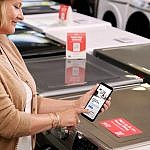Each Earth Day, we get a refresher on the importance of recycling. We set out our blue bins, take a moment to learn which plastics are recyclable, and remind ourselves to do better by cleaning out our yogurt lids before putting them in the recycle bin. At this point, you might feel like recycling common household items is second nature. But when it comes to items that are disposed of less often–like recycling furniture, mattresses, or appliances–we find that we don’t know how to recycle them.
Not everything can be recycled, and the sad truth is that some things are going to end up in landfills. But furniture, home products, electronics, and even mattresses are easier to recycle than you may have imagined. This guide has ideas for how to break down and responsibly dispose of those weird items in your home so you can embrace Earth Day in all parts of your home.
Best Practices for Waste Disposal

Before you try to recycle anything, see if it really does need to be disposed of. Oftentimes, the item in question may still have life left in it.
If it’s valuable, try selling it on Craigslist or another resale site. To sell it fast, keep your price low, or sell it for the best offer. Make sure to write a standout post to get as many offers on your item as possible.
You can also donate your items. The simple act of bringing your unwanted furniture to your nearby donation center can help your furniture find a whole new life.
But if selling is not an option, nor is donating, read on below to see how to recycle all your odd household items.
How to Recycle a TV

Televisions are one of the largest and hardest to recycle electronics on the market. You have a few options to recycle them.
Bring your TV to your local electronics recycler. To find a local e-waste recycler, just search “[city name] electronics recycler” online. You can drop off your TV and they’ll take care of all the breakdown and recycling for you.
Return your TV to the manufacturer. Sony and other TV manufacturers have return programs, where you can search their site to find the nearest location to you for returns.
Use the Best Buy Electronics Recycling Program. They’ll take almost any electronic device and responsibly recycle it.
For more ideas on how to recycle a TV, check out our complete guide to TV recycling and disposal.
How to Recycle Electronics

Computers, old VHS players, outdated radios, your old iPhone 5. Just take a quick look through your home, and you’ll find you have plenty of electronics to recycle. Here’s how to recycle them responsibly.
Clear your data first. The last thing you want is five year’s worth of data ending up in the wrong hands. If you’re getting rid of a computer, phone, or laptop, search online for instructions on how to clear your hard drive (the process will vary by device and manufacturer).
Bring your electronics to a professional e-waste recycler. Just like with TVs, bringing your old electronics to an e-waste recycler is the best way to ensure they’re responsibly taken care of. Check out the EPA’s official partners to find companies participating in electronic recycling by return programs, or use E-Stewards to find your nearest responsible recycler.
How to Recycle Large Appliances

The most dominant material in most large appliances is steel–y’know, that material that is the most recycled material in the world. So it makes sense to recycle appliances, not leave them in a landfill to rot.
Before you recycle your large appliances, make sure to prep it by following these two steps:
- Unplug your appliance and let it cool down. For refrigerators and freezers, allow at least 3 days to cool. For all other appliances, you’ll need at least a few hours depending on the size.
- Tape all doors and drawers shut to avoid opening during transport.
Once your appliances are prepped, there are a few ways you can recycle them.
Your first option is to contact your local garbage utility. Many of them offer appliance pickup for a small fee, you just have to bring your appliance to the curb. The downside of this option is that you often will have to wait for a specific collection day a few weeks in the future, or will need to bring it out yourself (a tough task when your dryer is on the second floor). You can always get labor only help from Dolly to bring your appliance out to the curb.
Another option is to contact the appliance’s manufacturer for recycling. Many manufacturers offer an incentive program, in which they pick up your old appliance from you and give you a discount on a new one (as long as it’s from the same manufacturer).
Finally, you can sell your appliance to a scrap metal recycler. The payout is small, but it might help you recoup a small portion of the cost of buying a new one.
Need help getting your old appliance to the recycler? Book a Dolly, and we’ll tackle the heavy lifting and transport of your old appliance.
How to Recycle Mattresses (and Other Furniture)

While you can take many of the same actions as above to recycle a mattress, there is one more option for recycling mattresses that’s well worth it. You can break the mattress down yourself. Here’s how to break down and recycle your mattress:
- Using a box cutter or knife, cut the mattress seam all the way around.
- Rip the fabric sides and fabric top cover off the mattress. The fabric can be tossed in the garbage.
- Put on a pair of study work gloves to avoid pinching yourself with the metal.
- Separate the interior padding from the coil. Most of these interior sections are made of compostable materials, like cotton, but you’re best double checking before bringing it to a composting facility.
- Remove the fabric bottom and any remaining fabric from the mattress.
- By now, all you have left should be the metal springs. Using a wire cutter or bolt cutter, cut these into smaller sections. From here, you can bring the springs to a metal recycler to be reused.
Trying to figure out how to recycle your other furniture? This same method can be used on almost all furniture. To recycle your furniture, simply break it down into its parts, remove the upholstery, and recycle the base material–typically wood or metal–through the appropriate channels.
How to Recycle Paint

Paint is a difficult thing to dispose of, let alone dispose of responsibly. There is some good news: when sealed properly, paint lasts 10-15 years. So before you look at how to recycle your paint, see if it’s still new enough to be reused.
If it is, you can keep it for your own use, or you can donate your paint. Check with your local Habitat for Humanity branch to see if they could use it in a home construction project. Or talk to your local high school drama department or performing arts center, as they might be able to put it to use in building sets.
On the other hand, if your paint cans are empty, you can simply recycle them with standard metal recycling.
But if your paint is past its prime (pun intended), you’ll need to properly dispose of it. To do so, pour the paint out into a box filled with cat litter. Stir until the paint becomes mostly solidified, then throw away the paint and cat litter concoction with trash. You can then put your empty paint can in the recycling.
Why Recycling Your Furniture Matters
According to the EPA, 12 million tons of furniture gets thrown away every year, and 75% of the furniture that’s disposed of ends up in landfills. So when you recycle your home furnishings and furniture instead of throwing them away, you’re making a positive change in the environment. True, it isn’t as simple as leaving it out on your curb to be taken away, mother nature will thank you in the long run for choosing to recycle.
We can help make recycling your oversized items easier. Dolly can send you a truck and Helpers to pick up your outdated washer, unwanted mattress, or even your old TV to bring to the recycling center of your choice. Let Dolly handle the heavy lifting, and you can rest easy knowing your large items are being recycled.
Dolly helps you move on your schedule and at an affordable price. Book now and see the difference: https://dolly.com.






